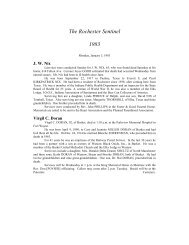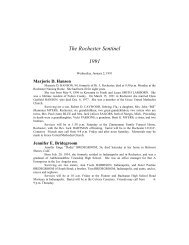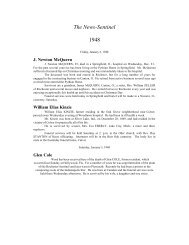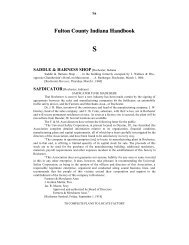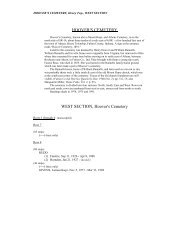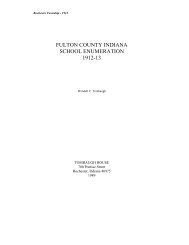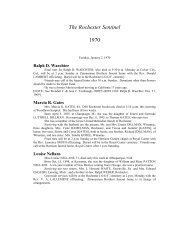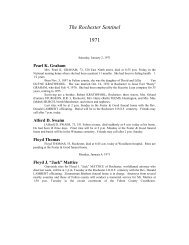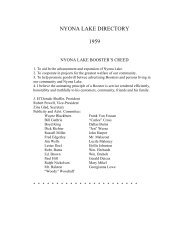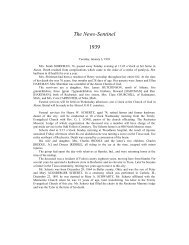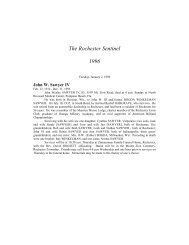Handbook N-P - Fulton County Public Library
Handbook N-P - Fulton County Public Library
Handbook N-P - Fulton County Public Library
Create successful ePaper yourself
Turn your PDF publications into a flip-book with our unique Google optimized e-Paper software.
Pa<br />
A brick making machine that will produce 30,000 concrete bricks in a working day and<br />
promises to revolutionize the industry is the invention of a former Rochester man, Frank Wilder,<br />
son of James Wilder, of this city. Moreover the machine is now in operation at the Wilder home<br />
on South Main street, where Frank is spending some time with his father and sister and perfecting<br />
the minor details of the outfit. He has made his home in Los Angeles for the last 16 years and it<br />
was there that he invented the device and has had it in operation for several years.<br />
Mr. Wilder’s machine covers only about 3 by 18 feet of ground space and is about six<br />
feet high. It is constructed entirely of steel and is very simple in operation and most important as<br />
the inventor says - is foolproof. The product is a brick made of concrete similar to the method used<br />
in producing concrete blocks. The machine turns out twenty bricks at one time and in its present<br />
order most of the work is automatic while some must be done by hand.<br />
The concrete is mixed as usual and is placed into the molds either by hand or by a<br />
conveyor. The machine itself is run by a motor. Heavy tampers immediately begin to rise and fall<br />
and pack the concrete solidly, and in a moment’s time. The tampers halt, one lever throws back the<br />
sides of the molds, another lifts the bottom of the mold upward and twenty bricks are lifted off the<br />
machine and placed on curing shelves. They can be surfaced with any color by stuccoe either of<br />
the latter lasting as long as the brick themselves. They are finished with the smooth or rough<br />
surface as desired.<br />
Each brick has a groove, on both sides which when filled with mortar and placed against<br />
another makes a perfect lock, and an entire wall so constructed is as strong as solid concrete or<br />
even better. And as the inventor claims, the bricks can be made and sold much cheaper than the<br />
old baked brick and are stronger, and have better fire resisting qualities.<br />
Mr. Wilder has seen many large building erected in California with his brick and the<br />
demand continues. However he is interested in marketing the machine, which is fully patented and<br />
hopes to start producing them sometime in the near future. He says the machine can be seen by<br />
anyone who cares to see it in operation at its present location at the Wilder home.<br />
[The News-Sentinel, Rochester, Indiana, Wednesday, August 5, 1925]<br />
ROBERT GREEK PATENTS A COLLAPSIBLE CRIB<br />
By cutting in half the number of operations necessary for setting up and taking down,<br />
Robert P. Greek of this city has obtained for himself a first patent on a collapsible crib, of primary<br />
value to tourists and travelers.<br />
The young man, who operates the shining stand in the Brubaker and Paramore barber<br />
shop and a furniture repair and cleaning shop in the rear, Friday morning received his patent<br />
papers from Washington, D. C.<br />
Mr. Greek has not sold his patent as yet - in fact has not had time to adjust himself to the<br />
news that he had really won his first patent. He may decide to manufacture the article himself -<br />
probably will do that for a while, at least.<br />
His patent application was filed July 25, 1924, and the patent has resulted from efforts of<br />
a registered patent attorney in Mr. Greek’’s behalf.<br />
The device, when standing is 38 inches long, 20 inches wide and 30 inches high. When<br />
closed, it rolls up into a bundle about eight inches in diameter and 38 inches long.<br />
Around the frame, consisting of four upright and eight horizontal bars, are wound two<br />
double thick sections of ducking or canvas, the top being left open. The sections have loops for the<br />
insertion of the bars of the framework. One section is stretched from one upper horizontal end bar<br />
to the other, while the second section is run from upper side bar to upper side bar.<br />
The bolts, one at each of the eight corners of the crib, constitute the clever feature of the<br />
invention. Fastened on the end of each horizontal end bar is a plate with a hole through it. A bolt<br />
comes through each upright, with the headless end passing through the hole in the horizontal end<br />
bar’s plate. A wing nut is the fastener here. Now on the end of the horizontal side bar there is<br />
fastened a fork plate which hooks over the head of the bolt. When the wing nut is fastened,<br />
drawing the upright and horizontal end bar together, the horizontal side bar at that juncture is<br />
likewise tightened. This saves a bolt at each of the eight corners.




